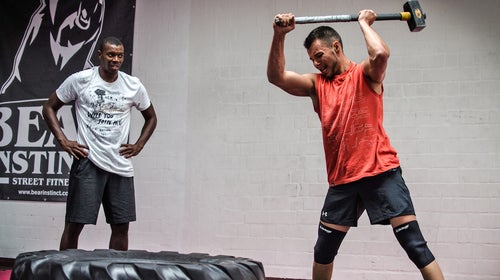If the surging popularity of CrossFit competitions, obstacle races, triathlons, and traditional road races tells us anything, it’s that competition fuels people to tackle their fitness goals.
The ability to see how you stack up against your buddies and community is partially why social applications like Strava and MapMyFitness exploded in popularity. But most apps and trackers that include a social function only deliver one metric of fitness—you wouldn’t know, for instance, if the Strava buddy you outran this morning also logged a kettlebell circuit before his run.
Enter FitRankings, a new fitness tech company that made its national debut at Austin’s SXSW festival. They’ve developed a virtual fitness arena that aggregates all your fitness data into a holistic fitness score, which the company then uses to rank you among other people in your city and workplace. In other words, it’ll let a runner objectively compare his fitness to a cyclist. Or a CrossFitter to compare herself to a runner. Or a CrossFitting runner to compare himself to a climber. You get the idea.
FitRankings culls data from more than 100 fitness tracking platforms—everything from a FitBit or Polar heart-rate monitor to mobile applications like Strava—runs some numbers, and gives you a fitness score recorded in MET-minutes.
A MET, or Metabolic Equivalent, is an expression of an activity’s intensity compared to your resting metabolic rate. One MET is equal to what you burn while resting. Doing an activity worth 10 METs burns 10 times the energy compared to being at rest. MET minutes are simply METs multiplied by time.
“It’s actually a pretty smart metric for this because it tells you how long and hard a person is working. MET minutes let you know what your workout is really worth.”
For example, if a leisurely stroll is worth three METs and kettlebell swings are worth 12 METS, then a person who strolls for 10 minutes racks up 30 MET minutes, while a person who completed five minutes of kettlebell swings tallies 60 MET minutes.
The CDC recommends that you log anywhere from 500 to 1,000 MET minutes each week. That range is associated with a host of benefits, such as a reduced risk of early death and various cancers.
“Taking data from different fitness monitoring devices then boiling it down to MET minutes allows us to provide people with an apples-to-apples fitness comparison,” says Patrick Hitchins, the CEO of FitRankings. “It gives you a true fitness score.”
Fitness experts agree. “It’s actually a pretty smart metric for this because it tells you how long and hard a person is working. And it cuts out variables—such as someone’s fitness level—that some popular measurements such as VO2 can’t account for,” says Pat Davidson, former professor of exercise science at Springfield College, and current training director at New York City’s Peak Performance fitness center. “MET minutes let you know what your workout is really worth.”
Of course, the service only works well if you use fitness racking gadgets and applications religiously. So a single untracked workout can dent your ranking.
The website-based service is currently available in 13 different cities for free. The company makes its money by signing on corporate users looking to drum up friendly competition between co-workers or between different companies. For example, vacation rental website Home Away recently used the service to launch a campaign to entice workers to move more; whichever employee logged the most MET minutes at the end of a period won tickets to Austin City Limits.
The upshots for the companies who buy into the service are varied. A recent German study showed that active CEOs tended to run more profitable companies. FitRanking’s Hitchins, meanwhile, believes using his service may help lower health insurance premiums for participating companies. “There are tons of benefits to having fit employees. Insurance companies are actually starting to recognize fitness data to determine premiums,” he says. “We put all of someone’s fitness data in one place, into one number.” Insurance underwriters may find that simplicity attractive.
Whether or not you care about the competition—or corporate—factor, Davidson notes that performance numbers are one of the best ways to motivate a person to improve. “Data keeps people honest,” he says. “A number lets people know exactly how hard a certain workout was. People naturally strive for a high number, and then they want to beat it the next workout. So you could use this individually to make sure you’re working hard enough, and logging enough exercise in general. ”
Possibly the best part? Now you can see if your cyclist friends really are fitter than you. Let the fitness wars begin.


